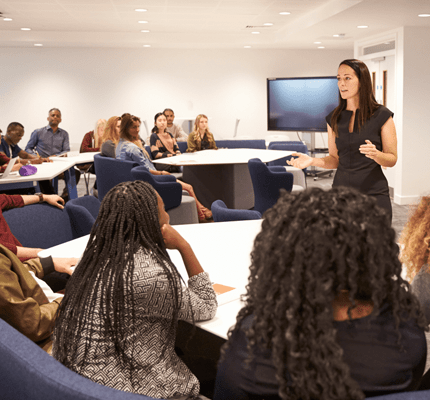
Using Student Feedback to Create Best Practices for Classroom Inclusivity
University students come from a variety of backgrounds and experiences. How can classrooms be more inclusive? What are students’ perceptions of how instructors can foster inclusivity? In a new article published in NCA’s Communication Education, Sandra L. Faulkner, Wendy K. Watson, Madison A. Pollino and Jaclyn R. Shetterly examine classroom inclusivity through Feminist Participatory Action Research (FPAR).
Inclusive Pedagogy
A key component of inclusivity in the classroom is inclusive pedagogy, which seeks to create a supportive environment and “to challenge the normative classroom ‘structures, practices, and curricula’ that disempower marginalized student populations.” According to Faulkner, Watson, Pollino, and Shetterly, inclusive pedagogy has expanded from adapting to different learning styles to recognizing the importance of social identities, such as race, class, nationality, ability, and gender, so that all students feel included and welcome in the classroom.
Teacher Immediacy
Teacher immediacy is another factor that affects whether a classroom feels welcoming and inclusive to all students. Instructors’ verbal and nonverbal behaviors can influence whether students feel a sense of connection with an instructor, which can foster engagement and learning in the classroom. The authors write that “Verbal immediacy behaviors include referring to students by their names, asking how students are doing, using correct pronouns, and giving students the opportunity to articulate their thoughts and opinions. Nonverbal immediacy behaviors can include making eye contact with students, smiling, and moving around the classroom.” Online immediacy may take the form of using emojis and engaging with discussion boards.
Supportive Communication
Supportive communication also plays a role in creating a welcoming environment by ensuring that all students feel that their instructor cares about their well-being and success in the classroom. Supportive communication includes messages that recognize the struggles that students are facing inside or outside of the classroom and messages that emphasize that the instructor is available to talk with students about various issues.
Feminist Participatory Action Research (FPAR)
FPAR prioritizes “collaboration, power sharing, and different knowledges.” The researchers sought to understand from students themselves which classroom practices made them feel welcome and included. Faulkner, Watson, Pollino, and Shetterly conducted six focus group discussions with 39 students to gauge their perceptions of teaching practices. During these discussions, students shared their thoughts on teaching practices. The researchers then analyzed the discussion and identified two major themes: (1) instructor behaviors before and during class interactions and (2) transforming power differences.
Instructor Behaviors Before and During Class Interactions
The results showed that there are specific things that instructors can do before the semester begins, such as contacting students to provide information about what the course will entail. In addition to making students feel welcome, this activity demonstrates that the instructor is engaged in the class. Instructors also can take proactive steps to learn more about students’ circumstances prior to the semester by sending out a survey that asks students about themselves or by calling students to discuss any special circumstances students may have, such as parenting a child.
Students felt that the first day of class sets the tone for the semester. For example, instructors can set expectations related to appropriate and respectful class discussions and make clear that discrimination is prohibited in class. In addition to creating an atmosphere that is conducive to group discussion, “instructors should also ask students for their pronouns and names, as well as use and pronounce those correctly.” Respect for students’ identities is critical to fostering inclusivity in the classroom. Students also mentioned that instructors can cultivate a group atmosphere by asking students to share contact information with a few other students in the classroom in case they are absent later in the semester.
According to the students, approachability throughout the semester is important. The authors write that “if an instructor is easy to talk with, personable, approachable, open, encouraging, recognize[s] the whole student, and do[es] not reinforce rigid power hierarchies, they [are] seen as welcoming and approachable.” Other factors that students considered when noting whether an instructor is approachable were using students’ pronouns, referring to students by name, and asking students about their personal lives. In addition to approachability, students also voiced support for providing campus and community resources, using trigger warnings for potentially distressing material, crafting inclusive teaching materials that incorporate a code of ethics, and providing alternative options for assignments.
Transforming Power Differences
Within the classroom itself, there can be a power differential between the instructor and students. This power difference can be mitigated by “talk[ing] with students, not at them… [and] treat[ing] students like individuals.” Faulkner, Watson, Pollino, and Shetterly write that “students [say they] feel included in the classroom when instructors are ‘kind and they treat you like a person, rather than just another number.’” Similar to instructor approachability, the development of instructor-student relationships is crucial to flattening the power difference between instructors and students.
Conclusion and Best Practices
The research team produced a table of “Best Practices for Inclusive Classroom Instruction” (see table), which includes suggestions for both online and face-to-face teaching. Faulkner, Watson, Pollino, and Shetterly conclude that their research highlights the importance of reflexivity in teaching and the student-instructor relationship. By reflexivity, they mean understanding one’s own biases, as well as reflecting on power differences in the classroom. Student-instructor relationships are also key to creating a welcoming and inclusive environment.





